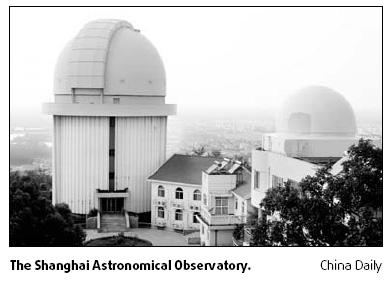
SHANGHAI: China's second largest optical telescope at the Sheshan branch of the Shanghai Astronomical Observatory can no longer participate in world-class observation due to excessive light pollution in the area, astronomers said.
Even routine space observations are being affected by light pollution, Yu Nanhua, a researcher at the Sheshan branch, said yesterday.
The observatory equipment needs to be moved elsewhere to continue the astronomy research, he said.
Unlike air and water pollution, light pollution has long been ignored by the public in past decades in China, as it does not present clear evidence to support a threat to public health.
Light pollution is a broad term that refers to multiple problems, all of which are caused by inefficient, unappealing, or unnecessary use of artificial light.
Astronomers require observations of extremely faint objects that can be made only with telescopes at sites free of light pollution.
According to the International Astronomical Union, the artificial light background for a world-class observatory should be less than 10 percent. However, light tests at Sheshan branch far exceeded the standard.
"Our telescope used to spot stars with magnitudes of 17 or 18. However, at the moment, we are only able to catch magnitudes of 13 or 14,"said Zhao Junliang, the former head of Shanghai Astronomical Observatory.
The failure of the telescope, with a 1.56-m diameter, was caused by the dazzling lights of Sheshan area.
The Sheshan branch of Shanghai Astronomical Observatory was built on Sheshan Mountain about 38 km away from Shanghai, which was considered an ideal place for astronomical observation in the past.
However, with accelerated economic growth and increasing urbanization, Sheshan has developed into a sightseeing destination for tourists. This led to streetlamps, floodlights and hotel lights, which has brought negative effects to astronomical observation.
Even though the Sheshan branch installed better observation instruments in the last few years, the result was still unsatisfactory.
The Shanghai astronomical observatory personnel have decided to move some of its equipment to Zhejiang province and establish China's first night sky protected area in Tianhuangping, Anji city.
However, the process is not that simple.
"It is very difficult to transfer a 1.56-m diameter telescope to another location. The transportation price is as costly as building a new one," Zhao said.
Shanghai is not the only city that faces this situation. The world-famous Greenwich Observatory was moved out of London due to light pollution as well.
Many countries in a similar situation have built their astronomical observatory overseas. Places such as Hawaii and Chile are ideal, as they are less explored.
"That is an option worth considering. The remote-monitoring observations have come to maturity, and used widely," Zhao said.
But astronomers aren't the only ones affected by light pollution. Ordinary citizens are as well.
Medical research proves that excessive light surrounding the human body causes a variety of adverse health effects, including increased headaches, stress, and anxiety, as well as a decrease in sexual function, according to You Jianxin, deputy director of the Research Institute of Science and Technology Management at Tongji University.
Also, the incidence of eye disease is higher in city residents than in country residents, due to light pollution, You said.
A limited understanding of the problem has led to serious light pollution, so the establishment of relevant regulations is a key factor in dealing with this issue, You said.
One improvement will be that LED lights will be used at the Shanghai Expo to reduce light pollution, according to local reports. LED lights provide illumination in one direction, instead of emitting light in all directions, experts said.